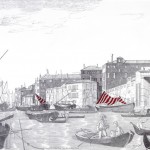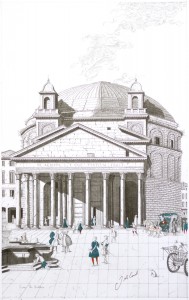John M. Canal
John M Canal is the great, great. great. great nephew of “Caneletto” Giovanni Antonio Canal. Canal’s works are fine-line fully crosshatched drawings with a touch of watercolor. His drawings are interpretations of and inspired by a series of oil paintings done during the Venetian Republic by Giovanni Antonio Canal. They reflect the times of the Venetian Republic 18th century Venice, as well as Rome, Italy and London, England.
Each of John M Canal’s works takes thousands of hours over many months to create. His highly detailed drawings reflect his meticulous hand and patient dedication to his work as he re-imagines and reiterates his heritage. Canal comes from a long line of Venetian and Milanese View artists, which is evident in his works. Each line is precisely placed in order to construct the story of Canaletto’s past. Through Canal’s delicate use of selective color, small details come to light as the narrative unfolds. John M Canal lives and creates his masterpieces in Toronto, Ontario.
“This drawing depicts the Customs House at the Customs House Point being ignored and bypassed by most everyone. Some of these transgressors can be seen in the foreground with their keg of wine. The lagoon harbour is on the left.”
“The original Pantheon was built by Marcus Agrippa in the year 27 BC and the inscription reads, ‘Marcus Agrippa, son of Lucius, Three times Consul’. Marcus Agrippa had a reputation of ruling with fairness and honesty to all and he was responsible for designing much of Rome’s aqueduct system. After a fire, the Pantheon was rebuilt by the Emperor Hadrian and in 1646 Pope Urban the VIII added the two clock towers. The pontiff Urban’s changes did not meet with the approval of the populace, the twin clock-towers becoming known as ‘The Ass’s ears’. Although depicted herein, the two towers are no longer there, having been removed in the late 1800’s.”
Click below to view a slideshow of Canal’s work:
http://www.youtube.com/watch?v=u688sX2p-CM&feature=plcp/“
 Chabot Gallery
Chabot Gallery
